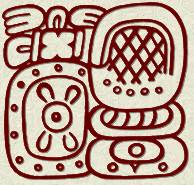
![]()
By Marc Zender and Joel Skidmore
The names advanced by epigraphers for the rulers of Palenque have varied tremendously over the course of time due to ongoing advances in both the methodology and findings of epigraphy, the science of deciphering hieroglyphic writing.
Thus, the great ruler commonly known as Pacal became Hanab Pakal when the "propeller" element of his name glyphs was recognized as a unique and independant sign: the word for a type of flower. He became K'inich Hanab Pakal when mah k'ina was more convincingly read as K'inich, based on complete phonetic substitutions and complementation, and was further demonstrated to have been an actual part of his name (rather than merely an honorific title).
In order to better reflect the actual Mayan pronunciation, Pakal's name can also be spelled K'inich Janahb' Pakal, where the apostrophes represent glottalization (in the case of the K') and implosion (in the case of the b'). The initial 'j' of Janahb' reflects a "hard" (velar) h, not unlike the Spanish jota or the raspy sound in Scotish loch. The internal 'h' of Janahb' is softer, though still pronounced with a somewhat raspy (glottal) sound just before the b'.
These increasingly-precise approximations to the actual sounds spoken in ancient Maya courts are the product of decades of intensive decipherment. In the wake of these breakthroughs, some orthographic refinements and alterations are to be expected (as was the case, for instance, throughout the entire process of the decipherment of the Egyptian script).
By way of example, here are variants of the names of Pakal and four of the rulers who are known to have followed him:
